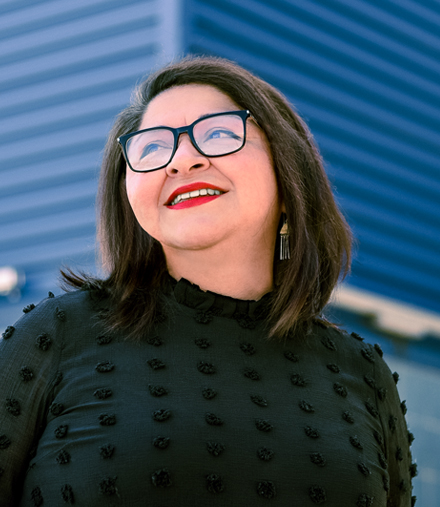What is Brand Identity? How to Align Your Brand With Your Ethos
In this episode of Solving for B° our experts examine the process of creating a brand that aligns with and accurately conveys a company's ethos. We'll also discuss which brand elements make up an identity and offer tips on how to make sure all your work is in perfect harmony.
Read the Transcript
*This transcript has been edited and formatted for readability.
Defining Brand Identity
Chris W: Welcome back to another episode of Solving for B°. I'm Chris Wilks, Digital Content Strategist here at BrandExtract. And today we're going to discuss brand identity and how to create a brand that accurately communicates your brand story.
To help us break down the topic, I'm joined by Senior Designer, Chris Jones; Senior Copywriter, Jeff Lane; and Director of User Experience, Cynthia Stipeche.
So to start off, let's define brand identity. What are the elements that make up a brand identity?
Jeff: Any way by which a customer interacts with your company: your name, signage, a commercial on the radio, a video on your website or a salesperson – they all make up your brand’s identity.
Any way that your company is expressed to a customer or a vendor is an element of your brand. So when we're developing a brand you need to make sure that all of those various touchpoints are consistent.
Chris J: There are actual identity elements which typically consist of your logo, typefaces, color pallets, etc. But it can also be photography, illustration style, icon styles, even sounds.
If you think about cell phones and the little sounds they make, the Google Play and the Amazon Fire devices, and the sounds of the voices associated with those devices. All those are touchpoints; different pieces of your brand's identity system.
Chris W: It sounds like, even the way that your sales folks talk about your brand, the way they communicate, the things that they communicate, must be considered.
Jeff: All of it.
For example, if your company claims to be a good partner – whatever that service is, whatever they provide – if you talk about consulting and being a good partner with your customers, then your tagline can't just be about partnership. Every way that you communicate with your customers needs to be consistent. You need to have good customer service.
If you claim to be consultants and really helpful for your customers but they can't ever get you on the phone – that may not be a logo or an ad, but that is one way that your customer interacts with your brand. So it's important that you are consistent across all touchpoints.
Cynthia: Whenever companies have a logo, a look and brand standards, but aren’t really living the brand, it’s a problem. Are you exhibiting the traits of what that total brand promises? That really does trickle into all areas of the business.
Chris J: To design an accurate brand and identity, you must do research and figure out what the brand needs to be and put all the pieces in place so they look and sound trustworthy.
For example, a company might be pushing a message of, “Call us. We'll be your partner. We'll talk you through whatever we're selling.” But all of a sudden, their phone lines get blown up by people asking for help, and they weren't ready for that. Their people weren't trained to deal with that.
Now they have to make a choice. Are they really ready to have that service message? Are they going to be able to execute on it? Or do they need to go back to a different strategy?
Chris W: There needs to be cohesion, not only in the way that the designs work but also between the message and the operations of the company.
Chris J: That's what a lot of companies get wrong, miss or underestimate.
Creating an Accurate Brand Identity
Chris W: So, to have an accurate brand identity, what are some of the steps to go through? Is it a jump right in and start designing a logo or do you ask questions? Where do you start?
Chris J: We start with an assessment process. A lot of times it's referred to as a three-legged stool because you have to talk to your internal key stakeholders:
- Executive team
- Employees
- Clients and/or potential clients
By talking to all three of those people, you can look at the whole spectrum. What does the executive think they're doing? Do the employees agree with that? Do they even know what they're supposed to be doing? Do your customers agree?
Once you get that information, you can start looking through the data. And a lot of times you can find a gap that ends up being an opportunity they didn't even know they had.
When you build a system based on that, you're designing a logo and you're doing color, but you're really looking at the messaging more than anything else. You’re determining how to make sure that you're communicating what those gaps are and how to fill them.
Jeff: That three-legged stool that Chris mentioned really gives you an authentic, comprehensive look at the company and where they are so that when you're starting to develop the brand position, it's all authentic.
Then you know you're working with the real material and you can develop something that's true to the company. Otherwise, you're just asking someone to paint some pictures based on some assumptions.
Companies make an investment in upgrading or creating their brand. That investment needs to be valuable and it needs to deliver something that's true and solid for the company. If not, they're just spending money haphazardly.
Chris W: It needs to be substantiated. That's one of the things I love about BrandExtract and what we do: there's reason for everything.
It's easy to look at a brand like Nike and think, “That looks cool.” But there's an actual reason behind that. There's research, data and reasons for the way that things are designed beyond the logo.
Cynthia: That's taking into consideration and understanding who your customer or end-user is so that you develop a brand presence that speaks to that base. You have to understand your target audience.
There are brands that are more far-reaching, like Lego. They are not geared towards a specific age range or gender; it's open to everyone. But they can do that because they have the right message and the right kind of story that speaks to that broader audience.
Chris W: So the first step is an assessment. Where do we go from there?
Chris J: It’s not always required for the branding agency to do the assessment. Sometimes a company will come in and they've already done a little of that themselves, or they feel like they really do know who they are, and sometimes they're right. You can trust them.
So once you have all that – let's call it the research – then you start deciding and brainstorming ideas of what they will look and sound like; and that's when you get to start building the fun part.
That's when you actually build the brand identity, which is the collection of the logo, color, styles and all those pieces.
Jeff: Another thing the creative group does is research the competitors. Regardless of the story you want to tell, you want to make sure that the company is going to look and feel distinct and have its own identity.
You don't want to be a copycat. You don't want to look like the other people in your space if you can avoid that. So there's creative research and competitive research.
Chris J: If you look at the big players, color is really important. For instance, each of the major cell phone companies has a unique color. You want to make sure you're not using the same colors as everyone else in your space because color is a major identifier.
Blue is a super popular color so we always try to talk our clients out of going with blue. Most of them like blue because it's comfortable. But it's better to pick a color that stands out. And if you are going to go for blue, pick a shade that isn't being used by all your competitors.
Chris W: That's a really good point. I know that colors are a big identifier, but they also mean a lot. There's more thought behind the selection of each color, right? It's not just haphazard, “Oh we like the way it looks.”
It's more like, “We want to be thought of as safety company so we're going to use that safety yellow or orange…” Which may or not work, but there's thought behind why these colors, designs and shapes go into that.
The Process of Designing a Brand
Chris W: So, when you're designing the brand itself and the identity elements, is there anything specific that happens in the process? How do you come up with, sketch and design your ideas?
Chris J: It’s rather laborious. What we try to do is get more or less down to one story and one tone that expresses who they are. Usually, there are a couple of different visual ways to express that. So we'll create toolkits: a few different ways of looking at how that story can be expressed.
They can range from a little bit more conceptual to a little bit more conservative. Maybe one's a little bit louder and one's a little bit softer. This helps gauge the client's reaction to them and determine where to go next.
It's almost like different clothing. There are people who may put on dress shoes for a particular occasion, but they'd rather be wearing flip flops. This toolkit helps them decide what clothes their company should be wearing.
Chris W: What are some of the considerations in that phase? Is there anything specific you need to look at to come up with these different styles?
Chris J: There's a lot of different pieces that go into that. A company may be bigger and have a much larger budget, so when you're building these, you know that they can afford to do a photo shoot, for instance.
That may affect the types of images you use. But with a nonprofit who might not have as big of a budget, you try to create a system that relies more on color, patterns or illustrations that aren't going to cost as much to produce.
A lot of that goes on in the back of your mind while you're doing all this; you need to figure out a feasible solution. You can design something that's amazing and beautiful but that blows the client's budget, and then they never get to launch their brand.
Jeff: Within the budget, there are other considerations. If one of the company's strengths is that they have great personal relationships with their customers, their vendors and their people are a big part of that, you might consider showcasing that. Show the people in a positive light: being thoughtful and helpful.
There are also visual elements that can make something look very studious and smart. Perhaps you're a brand that's a thought leader and you want to be portrayed as someone who's sharing a lot of knowledge. So you may have a look that seems more sophisticated and scholarly.
Or, you may have a brand that's appealing to young people so you'd want to have some graphics that are edgy, forward-thinking or something that's going to appeal to younger people. There's a lot that goes into those visual decisions as well as the tone and voice.
If you’re someone who's sharing knowledge, you may want to sound a little bit more collegiate, so the language might be very proper and very formal. But if you're selling skateboards, you're not going to want to sound like that at all.
Ultimately, you want to sound like your audience. So in this case, the language might be a little sarcastic. It might have a little bit of an attitude in the tone.
All of these things are taken into consideration.
Chris J: That is another reason why that upfront research is really important. I've seen many cases of companies that tried to design something that looked young and hip because that was their perception of themselves, but it completely fell flat. And those actual young, hip kids wanted nothing to do with it.
If you don't do the research and talk to people, and you try to create something in a vacuum, it's going to be seen as inauthentic. And nowadays those brands get called out incredibly quickly.
Jeff: Young people are in tune with things much earlier than I am. People my age and me must make sure we're talking to those people, understanding them, hearing them – not just what they say but how they say it, to make sure we're authentic.
Cynthia: How we're delivering messages depends on the demographic and the age group. There might be instances where social media might not work so well.
If the audience is not very young, we might need to communicate with them via a more traditional medium. But younger audiences will be more receptive to online, social, fresh, new content. It’s a non-stop type of communication style.
So going back to the original assessment process and understanding who you're speaking to is very important. Sometimes that changes by industry. But there's also multiple layers within the industry: people who are about to retire, the new incoming folks who are taking over jobs, etc.
Even when you're looking at specific companies, traditional methods that they've leaned on may not work anymore. You must understand who you are as a company and who you're speaking to.
Chris W: As I mentioned earlier, the layperson may look at this and say, “That's a cool logo.” But there's a reason behind it. The same thing happens with the language, tone and voice of the brand. There are so many ways to describe something. There's different words to use and different verbiage that are all purposeful and thought out when done properly.
And Cynthia's point about knowing who you're talking to – I think that's crucial because ultimately you're designing a brand. The public at large is going to see it, but you want to design it so that it resonates with your target audience; with those that you've prioritized. So, defining those personas is a very important part of our process here.
Cynthia: And the brand promise. What's the big promise? What’s the mission, vision and values?
So if the promise is, “We deliver cutting edge technology that you've never, ever seen in your life,” and then there's a lag in there for five years where nothing new comes out, you're not living the brand. That's another element to take into consideration.
What Happens After the Brand Identity is Set
Chris W: Once you've come up with these concepts and you've narrowed it down to one and the client has decided the direction to go to, what's next?
Is it straight to execution or is there any other conversations that have to happen?
Chris J: Well, assuming that everyone's bought into it, the next step is planning the launching. Deciding whether to launch internally first or internally and externally at the same time.
There are a lot of challenges that go into that. A lot of the companies, especially those that we work with, have offices all over the country or even all over the world. So, how do you try to bring all these people together? There's a lot of logistical concerns with that.
And it's really important to get it right because you only get one chance to roll it out. And that's the message about what your company is, stands for and does. It comes all the way down from the CEO and it has to go through to all different levels of your staff.
Chris W: It's important to get it right internally first because these are the people that are going to embody the brand.
Jeff: They're ambassadors. They need to understand it and be able to use it.
During the assessment process, when you interview your employees at all different levels and different parts of the company, you're asking for their input. What do they think of the company? Where’s the company going? Where do they think the company should go?
You're getting their input early on so when you launch the brand later, there's a better opportunity for buy-in as they've been involved in the process because you've been listening to them.
These complicated launches that need to reach people in different times zones become a little bit easier if they've already been brought into the process. They're going to be asked to start delivering on the brand themselves.
Chris W: I assume that once we've launched and executed the brand, it's important to continue monitoring because things are going to change in the market. Your target customer is going to change, so you want to make sure you're staying on top of that and refreshing every so often. Is that accurate?
Jeff: Well, a brand is a living thing. Once you build and launch it, any time anyone interacts with it, it's affected or altered. When customers interact with the brand and have a positive reaction, they’ll probably post something on social media or tell friends and colleagues about the brand.
That's the brand living. And since you want those impressions to be positive, you have to monitor how that's going. Along the way, you might think, “We might need to make a few tweaks because here's some of the feedback we're getting. Here's how people are reacting to the brand.” There might be a few updates here and there.
Chris J: There's actually a new chain that's rolling out. A year ago, it was called Verts Kebab, which is a Mediterranean style sandwich kind of restaurant.
I went back there recently and looked at the menu. It took me a second to realize what was going on: they'd changed their name to Verts Mediterranean Grill (now changed to Noon Mediterranean).
I'm going to assume that there was probably some research that showed people didn't know what a kebab was. Or, maybe they wanted more than that; they were talking to their customers, watching their sales and they were able to do a flip and offer more different types of food.
That's an example of monitoring, watching what you're doing, seeing what's working and what's not. They didn't change their core of who they were and how they're training their employees, but they saw something was going on with what they were offering and they needed to make that change.
Examples of Good Brands
Chris W: Do you guys have any other particular examples of brands that do a really good job of adjusting their brands or having all the little details covered?
For instance, I think Disney does a really good job of branding across its theme parks, TV and movies. They do a really good job of taking care of the little details. In fact, that's one of the things I love about the brand: if you go to the theme parks, you can see they took the extra time to do everything.
Cynthia: When it comes to Disney, it doesn't matter whether it's a physical experience of the park, product, movie, television series, or video game; it's all consistent. It looks and it feels like Disney, regardless of what it is.
Jeff: Chunky Soup is another example. When I was a kid, I’d see commercials about this really hearty soup. It was heavy, the can had a maroon label, and it had a big block western-style type. So it was rugged and hearty, and the tagline was something like, “It's so thick you'll be tempted to eat it with a fork, but use a spoon to get every drop.” Which is a great old school tagline, and it was true to what it was.
More recently, they did some commercials with NFL players and their moms. I really enjoyed that campaign. They were speaking to both kids and moms.
You would see these rugged football players who needed heavy hearty meals to have the calories to do what they do every day. And the kids look up to them. But then you've also got the moms who are the heroes because they're the ones who are going to buy this for their kids.
It was really fun and I thought that was a real modern way to stay true to what their brand is.
Chris J: Earlier we were talking about making a brand for young people and rolling out something that's actually cool and hip. I think Apple has always done a really good job of that, specifically with their commercials.
Whoever is selecting the music for those is doing a great job. They'll pick a song before it's even popular, put in their commercial and within the next week, everyone is listening to it all the time.
And I guarantee you, they've got people doing research. So that's an authentic way to bring that experience to that demographic.
Chris W: Well guys, I think that wraps us up for this week. Thanks for joining us!




